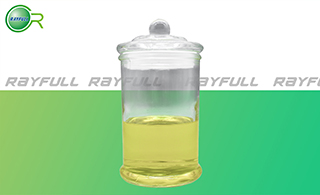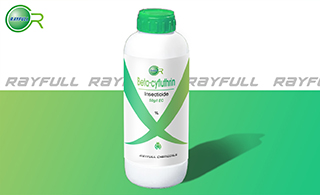Beta-cyfluthrin
    ёЯР§·ъВИЗиҫХхҘ ёЯР§·ъВИЗиҫХхҘ
Introduction: Beta-cyfluthrin is a pyrethroid insecticide effective against a range of common pests including migratory locusts, grasshoppers, mosquitoes, bedbugs, loopers, cutworms, spittlebugs, leaf hoppers, caterpillars, armyworms, weevils, stinkbugs in a many different crops, such as alfalfa, corn, cotton, peanuts, sorghum, sugarcane, sugarbeet, tobacco, wheat, brassicas, sweetcorn, stone fruit, root vegetables.
Common name: Beta-cyfluthrin
Another name: Temprid ™ SC Insecticide
Chemical name: enantiomeric pair (R)-a-cyano-4-fluoro-3-phenoxybenzyl (I S,3S)-3- (2,2-dichlorovinyl)-2,2-dimethylcyclopropanecarboxylale and (S)-a-cyano-4-fluoro-3- phenoxybenzyl (IR,3R)-3-(2,2-dichlorovinyl)-2,2-dimelhylcyclopropanecarboxylate in ratio 1:2 with the enantiomeric pair (R)-a-cyano-4-fluoro-3-phenoxybenzyl (lS,3R)-3- (2,2-dichlorovinyl)-2,2-dimethylcyclopropanecarboxylate and (S)-a-cyano-4-fluoro-3-
phenoxybenzyl (I R,3 S)-3 -(2,2-dichlorovinyl)-2,2-dimethy lcyclopropanecarboxylate
Empirical formula: C22H18Cl2FNO3
Structural formula:

Diastereomer I (lR,3R,aR + I S,3S,aS; I: I; cis)
Diastereomer II (1R,3R,aS + IS,3S,aR; 1:1; cis)
Diastereomer III (IR,3S,aR + IS,3R,aS; I: I; trans)
Diastereomer IV (lR,3S,aS + IS,3R,aR; 1:1; trans)
Isomer I (<2%), Isomer II(30-40%), Isomer III (<3%), and Isomer IV (57-60%)
Mol. Weight: 434.29 g/mol
CAS No.: 68359-37-5
Specifications
Leading Beta-cyfluthrin supplier
Beta-cyfluthrin 25 g/L EC
Beta-cyfluthrin 50 g/L EC
Beta-cyfluthrin 100 g/L SC
Beta-cyfluthrin 125 g/L SC
Beta-cyfluthrin 95% TC
Packing:
BULK PACKING
Powder: 25KG/Bag, 25KG/Drum, 50KG/Drum etc.
Liquid: 200L/Drum, 20L/Drum, 10L/Drum ect.
SMALL PACKING
Powder: 1kg/Alu bag, 500g/Alu bag, 200g/Alu bag, 100g/Alu bag, 50g/Alu bag, 15g/Alu bag etc.
Liquid: 5L/Drum, 1L/Bottle, 500ml/Bottle, 250ml/Bottle, 100ml/Bottle, 50ml/Bottle etc.
Customerized Packing label
Beta-cyfluthrin FAO standard
Professional registration
HAZARDS IDENTIFICATION
Hazard statement(s)
H300: Fatal if swallowed.
H331: Toxic if inhaled.
H400: Very toxic to aquatic life.
H410: Very toxic to aquatic life with long lasting effects.
Precautionary statement(s)
P261: Avoid breathing dust/fume/gas/mist/vapors/spray.
P264: Wash ... thoroughly after handling.
P270: Do not eat, drink or smoke when using this product.
P271: Use only outdoors or in a well-ventilated area.
P273: Avoid release to the environment.
P301+P310: IF SWALLOWED: Immediately call a POISON CENTER/doctor/...
P304+P340: IF INHALED: Remove person to fresh air and keep comfortable for breathing.
P311: Call a POISON CENTER or doctor/...
P321: Specific treatment (see ... on this label).
P330: Rinse mouth.
P391: Collect spillage.
P403+P233: Store in a well-ventilated place. Keep container tightly closed.
P405: Store locked up.
P501: Dispose of contents/container to ...
Supplemental Hazard Statements: none
MAMMALIAN TOXICOLOGY
Acute toxicity: 1) Acute oral LD50 for rat: >77 a.i.mg/kg. 2) Acute dermal LD50 for rat: >5000 a.i.mg/kg. 3) Inhalation LC50 (4 h) for rat: 0.081 a.i. mg/L. 4) Slightly-irritating to skin (rabbits). 5) very slight-irritating to eyes (rabbits). 6) Not a skin sensitiser (guinea pigs). The primary target for cyfluthrinlbeta-cyfluthrin is the neuromuscular system. In oral developmental studies in the rat and rabbit, there was no increased qualitative or quantitative susceptibility in the offspring. However, increased susceptibility was observed in inhalation developmental studies. Increased susceptibility was also seen in oral reproduction studies and in a developmental neurotoxicity study with beta-cyfluthrin. Cyfluthrinlbeta-cyfluthrin was classified as "not likely to be carcinogenic to humans." No evidence of mutagenicity was observed.
There was no indication that beta-cyfluthrin induced any endocrine disruption.
ADI (JMPR): 0.04 mg/kg b.w.[2006]
Classification:
Toxicity class WHO (a.i.): Ib (Highly hazardous)
US EPA Classification (formulation): II (Warning - Moderately toxic)
EC Risk Classification: T+ - Very toxic: R26/28; N - Dangerous for the environment: R50, R53
ECOTOXICOLOGY
Effect on birds: low toxicity to birds, acute LD50 for Bobwhite quail >2000 a.i.mg/kg. Effect on fish: high toxicity to fish, acute 96 hour LC50 for Salmonidae is 0.000068 a.i.mg/L. Effect on aquatic invertebrates: high toxicity to aquatic invertebrates, acute 48 hour EC50 for Daphnia magna is 0.00029 a.i.mg/L. Effect on algae: low toxicity to algae, acute 72 hour EC50 for Scenedemus subspicatus is >10 a.i.mg/L. Effect on honeybees: high toxicity to honeybees, contact acute 48 hour LD50 is 0.001 a.i.ҰМg/bee; Oral acute 48 hour LD50 is 0.05 a.i.ҰМg/bee. Effect on earthworms: low toxicity to earthworms, acute 14 day LC50 for Eisenia foetida is >1000 a.i.mg/kg.
ENVIRONMENTAL FATE
A low vapor pressure of 0.000056 mPa indicates that Beta-cyfluthrin is low volatile in air while a low HenryЎҜs law constant of 8.1ЎБ10-3 Pa m3/mol indicates non-volatility in water. If released to soil, Beta-cyfluthrin is expected to non mobility based upon a Koc of 73484-180290. In various soils, Beta-cyfluthrin has been observed to degrade rapidly and has shown little leaching potential. The hydrolysis half-life of 215 days at pH 7 suggests that Beta-cyfluthrin is not readily degraded in water; however, its degradation will increase with an increase in pH, DT50 is 1 year at pH 4, and 38 hours at pH 9. In vegetation, Beta-cyfluthrin does not penetrate significantly into plant tissues, and does not appear to affect photosynthesis, stomatal conductance, or transpiration rates. Beta-cyfluthrin is extremely toxic to fish, other aquatic organisms, and honeybees, but is relatively non-toxic to mammals.
Usage: The draft specifications was provided by Bayer AG in 1999. Beta-cyfluthrin is an insecticide, acting as a contact and stomach poison. It combines a rapid knock-down effect with long lasting efficacy. It is not systemic in plants. It is used in agriculture, horticulture (field and protected crops) and viticulture. It is also used against migratory locusts and grasshoppers and in public health and hygiene.
Application: Indoor and outdoor pests including roaches, silverfish, fleas, spiders, ants, crickets, houseflies, ticks, black carpet beetles, small flying moths, saw-toothes grain beetles, rice weevils, pillbugs, mosquitoes, wasps, hornets, yellow jackets, gnats, earwigs and more. Beta-cyfluthrin is effective against Lepidoptera, Coleoptera, Hemiptera and Homoptera on cotton, fruit, vegetables, cereals and other crops, at 7.520 g/ha. Also against migratory locusts and grasshoppers; and in animal health.
| 






